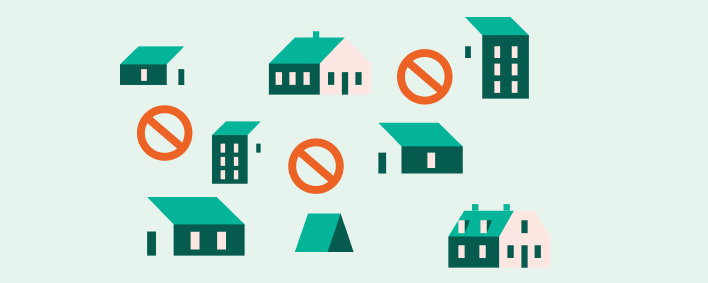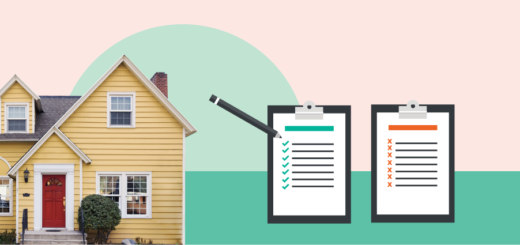Home Insurance Exclusions: What’s Not Covered?
Our goal is to give you the tools and confidence you need to improve your finances. Although we receive compensation from our partner lenders, whom we will always identify, all opinions are our own. By refinancing your mortgage, total finance charges may be higher over the life of the loan.
Credible Operations, Inc. NMLS # 1681276, is referred to here as “Credible.”
A standard home insurance policy protects your home and personal belongings against a wide range of perils, such as fires, explosions, and break-ins. But it doesn’t provide coverage for every unfortunate event. Some common home insurance exclusions include floods, earthquakes, and sewer backups.
If you need to protect your home against something your insurance doesn’t cover, you can add coverage for certain perils to your existing policy or purchase a separate policy.
Here’s what you need to know about home insurance exclusions and how you can add additional coverage:
What does home insurance cover?
A standard home insurance policy usually provides coverage for these six categories:
- Your home’s structure
- Other structures on your property (e.g., a fence or gazebo)
- Your personal belongings
- Liability coverage for bodily injury others suffer on your property and for damage you or your family members cause to others’ property
- Medical expenses if a guest gets injured on your property
- Additional living expenses if you have to temporarily relocate while your home is uninhabitable
What your home insurance covers depends on the type of policy you have and whether it provides open-perils coverage or named-perils coverage.
Open-perils coverage, also referred to as all-perils coverage, covers all events that can cause damage to your property, unless your policy specifically excludes it. By contrast, named-perils coverage only covers damages caused by the events named in your policy.
In some cases, your policy may provide a mixture of open- and closed-perils coverage. For example, some types of home insurance policies provide open-perils coverage for your home’s structure but named-perils coverage for your personal belongings.
With Credible, you can compare homeowners insurance quotes from top providers.
Here’s a look at what different types of home insurance policies typically cover:
| Type of Policy | What it Covers | Perils Covered |
|---|---|---|
| HO-1 (basic) | Named perils for structure and personal belongings |
|
| HO-2 (broad) | Named perils for structure and personal belongings |
|
| HO-3 (special) | Open perils for structure, named perils for personal belongings |
|
| HO-4 (renters) | Named perils for personal belongings |
|
| HO-5 (comprehensive) | Open perils for structure and personal belongings |
|
| HO-6 (condo) | Named perils for some structures, named perils for personal belongings |
|
| HO-7 (mobile home) | Open perils for structure, named perils for personal belongings |
|
| HO-8 (modified coverage) | Named perils for structure and personal belongings |
|
Learn More: How to Buy Homeowners Insurance
What doesn’t home insurance cover?
A standard homeowners policy covers many perils, but it typically doesn’t protect your home against certain disasters. You may be able to purchase additional coverage for these events. Perils that homeowners insurance doesn’t cover include:
Floods
A standard home insurance policy doesn’t usually cover loss or damage as a result of flooding. If you live in a high-risk flood zone and have a mortgage, your lender may require you to purchase a separate flood insurance policy.
Acts of war
If an act of war causes damage to your home, home insurance won’t cover it.
Earthquakes
Another natural disaster that standard home insurance doesn’t cover is earthquakes. If you live in an earthquake-prone area, consider purchasing earthquake insurance.
Lack of maintenance
If you don’t properly maintain your home, your insurance policy won’t cover damage related to that negligence. For example, if mold or termites damage your home, your home insurance won’t cover the repair costs. It’s important to do everything you can to keep your home in good condition.
Sewer backup
If your sewer backs up and causes damage to your home, standard home insurance won’t cover the cost of repairs. Flood insurance doesn’t cover sewer backups either.
How do you find out what home insurance exclusions apply to your policy?
Although homeowners insurance policies have some common exclusions, what a standard home insurance policy excludes varies based on several factors, like your home insurance provider and your location.
To find out what your home insurance doesn’t cover, review your policy. You can find the exclusions after the main coverage sections in your policy, as well as in the definitions, conditions, and endorsements sections. If you have any questions, contact your insurance provider.
See: A Guide to Your Homeowners Insurance Declaration Page
Coverage options to add to your homeowners insurance policy
If you need to add coverage, you can add a rider (also known as an endorsement) to your policy. Riders can provide coverage for certain unforeseen events. Riders are optional add-ons, but they can increase your coverage and may be well worth the cost, depending on your situation.
Here are some common home insurance riders you can add to maximize your home’s protection:
- Scheduled personal property coverage: If you have a highly valuable personal item (e.g., an expensive watch or piece of jewelry) and your current policy doesn’t cover its market value, you can increase coverage for it by purchasing this endorsement.
- Business property coverage: If you have a home-based business, a standard home insurance policy may not cover the full value of your business property. Adding this coverage could help you better protect business property (such as inventory) you store at your home.
- Water backup coverage: This coverage provides protection for your home against water damage from a backed-up drain or sump pump. Water backup coverage can help pay to replace furniture or remove water from your home.
Credible makes it easy to compare homeowners insurance quotes from top insurance carriers.
Disclaimer: All insurance-related services are offered through Young Alfred.




